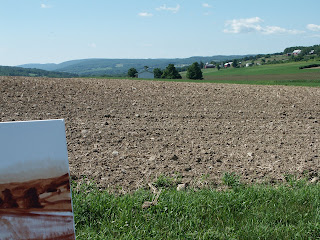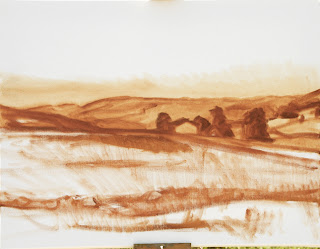| Painting by student Marilyn Feinberg |
| Painting by student Jennifer Jones |

Watch Me Paint: World-Class Art, World-Class Instruction
| Painting by student Marilyn Feinberg |
| Painting by student Jennifer Jones |
| I threw out 90% of my drawings, keeping only those of sentimental value. This could be nobody but my friend, clothing designer Jane Bartlett, posing for a quick sketch. |
I recently bought new pads of newsprint , and they tipped me into chaos. I finally faced the truth that there wasn’t a single corner in which to shove one more thing in my studio. It wasn’t a simple question of emptying one drawer to accommodate the newsprint, either. My whole studio had become a tangled skein of art supplies, finished work, and projects under way.
| And this, of course is my long-term plein air pal Marilyn Feinberg, being unusually still. |
| The plein air board stash. Neatly reduced (although I suspect there’s another box of them in my frame shop). |
Next up, my frame shop. That’s a scary thought.
Now that I’m so darn organized, I can start thinking about what’s coming up. There is only one slot open for my July workshop at Lakewatch Manor in Rockland, ME, and August and September are sold out. Join us in July or October, but please hurry! Check here for more information.
| The scene, on a warmer, brighter day. |
| As far as I got on an earlier day, painting with my old pal Marilyn. This is a big field painting, 20X24. |
| Students show up at all levels of experience, and the goal is to meet them where they are and usher them to the next phase. |
An inexperienced student is a tabula rasa on which the painting teacher can sketch out an orderly system for painting. (This is a sweet privilege, and one of the reasons I like teaching teenagers so much.) When working with experienced students, the challenge is to get them to let go of what they know in order to embrace the whole range of what they couldknow.
| Teaching painting is a great privilege. |
The pitfalls are plentiful. Some teachers churn out exact replicas of themselves, so that you can walk into a gallery and immediately know, “That person studied with X.” Others are so fearful of stirring the mixture that they do nothing to advance their students’ skills, providing only vague affirmation. Still others teach systems of rendering—“This is how you paint an eye;” “This is how you paint an apple”—instead of teaching their student to observe and describe with an authentic voice.
 |
| I found this while cleaning my room today, and somehow it seemed appropriate. I’m really big on making my students do self-portraits; maybe it caused Matt to become unhinged. |
Painting in Maine is definitely more interesting than falling off High Tor. If you’re interested in joining us for a fantastic time in mid-Coast Maine this summer, check here for more information. There’s still room in my workshops.
Marilyn Feinberg was raised in Irondequoit, so it is no surprise that she was drawn to Durand-Eastman Park. We painted there in every season, but this painting was done on a cold Spring day when we were still in down jackets and crocheted toques. Marilyn’s coat was orange and her hat purple, which is why (I think) a local news photographer spotted and photographed us. (I’ve been photographed painting innumerable times and never when well-dressed. Yes, that begs the question.)
 |
| Oakland Shores Motel and Cabins, Rockland, ME, 9X12, oil on canvasboard, painted while traveling with Kristin Zimmermann. |
| Lake Champlain from on top of a stupid cliff, 11X14, oil on canvasboard |
Marilyn’s backyard, about 8X10, oil.
Our grill, about 8X10, oil.
These paintings will be on display in the community room at Barnes & Noble,
Marilyn is certainly talented—no doubt about that. But she brings to mind that famous Thomas Edison quote: “Genius is one percent inspiration and ninety-nine per cent perspiration. Accordingly, a ‘genius’ is often merely a talented person who has done all of his or her homework.”
And on that note, I’m getting to work.
When my friend Susie arrived at the farm where we’d agreed to meet, she raised her arms and said, “Paradise!” It was a lovely farm alright, but Paradise?
We wandered. We looked at bales of hay in a pole barn and hiked to a rise where we could look down on the dairy barns. (Marilyn and Susie had previously met the farmer.) This was indeed a well-run and beautiful farm, set in a gently sloping valley.
I asked them why they liked this place. Susie said she was enthralled by the colors and the roll of the land. Marilyn said she saw the human figure in the sinuous twists of the hills.
The Bristol Hills aren’t breathtaking but they are gently beautiful. Long ranges of blue hills overlap in the distance. I never respond to these hills in their purely natural state. I need to see that slash of pale gold in a faraway upland field to understand the lavender and indigo and green of the woods.
The Kingdom of Heaven is in some ways a cooperative venture between God and man. So is this landscape. No wonder Susie called it “Paradise.”
I continue to try to paint in the spirit of the Group of Seven and Tom Thomson. This isn’t really their kind of scene, but the wide disked field presents some of the paint handling issues they addressed. I chose this view for the difficulties presented by that large neutral foreground.

I was working on a 16X20 canvas, a breath of fresh air after all the small studies I’ve done this month. I started with an underpainting in Gamblin’s Transparent Earth Red. You can read more about their transparent Mars colors here.

Although I’ve been trying to work much dryer, the transition from board to untoned canvas makes that a little more difficult. The shadow above the hills is from erasure and isn’t really part of the value study.
Here is the midpoint of my painting. I have decided to do a potentially ugly thing and include the fringe of green at the bottom. As long as the value of the green and the brown are close, I don’t think it will be too awkward-looking.
I still have to unify the sky (yes, there were clouds; they showed up after I started). I have to figure out a paint-handling technique that works for the disked field and make some drawing adjustments on the hill to the right. But, oops! My easel fell and dumped my painting into the ditch.
There are bits of gravel, seeds, and dirt all over the right side of my canvas. The solution is to stop painting, let the surface harden up, and knock the debris loose with a palette knife. Oh, well. I was ready to quit anyway.
BTW, this is my painting buddy Susie:
Ironically, when they aren’t wearing billowing white shirts and off-kilter ball caps (to keep the glare out of their eyes) they are both very elegant women.